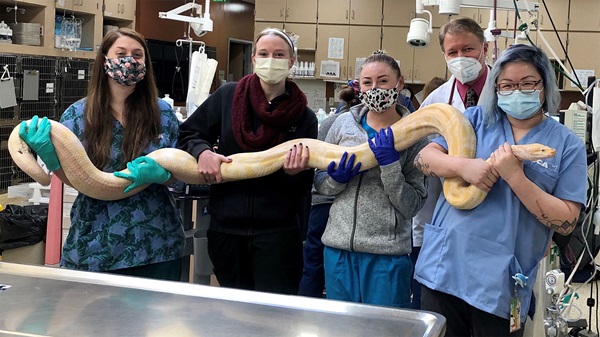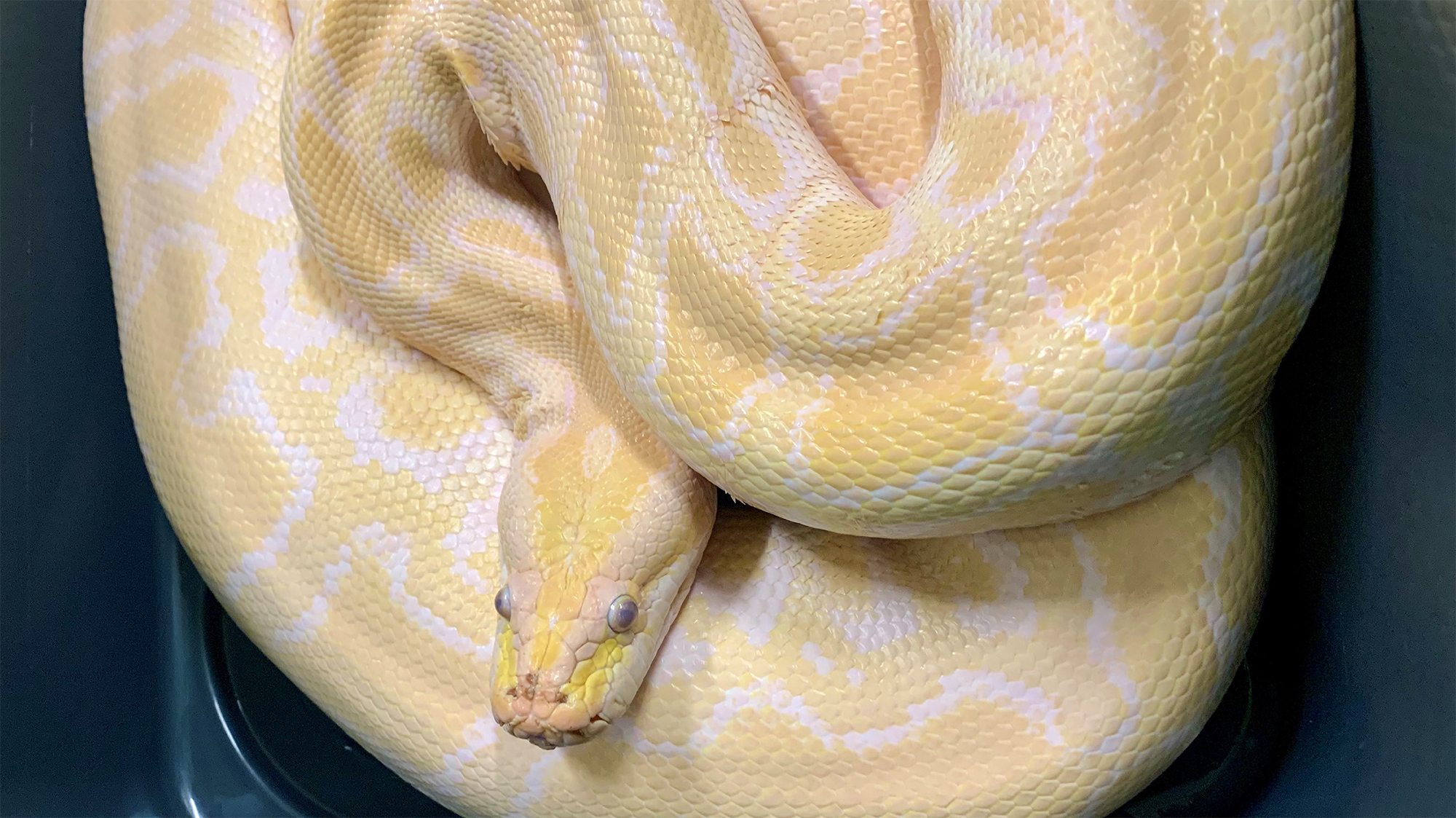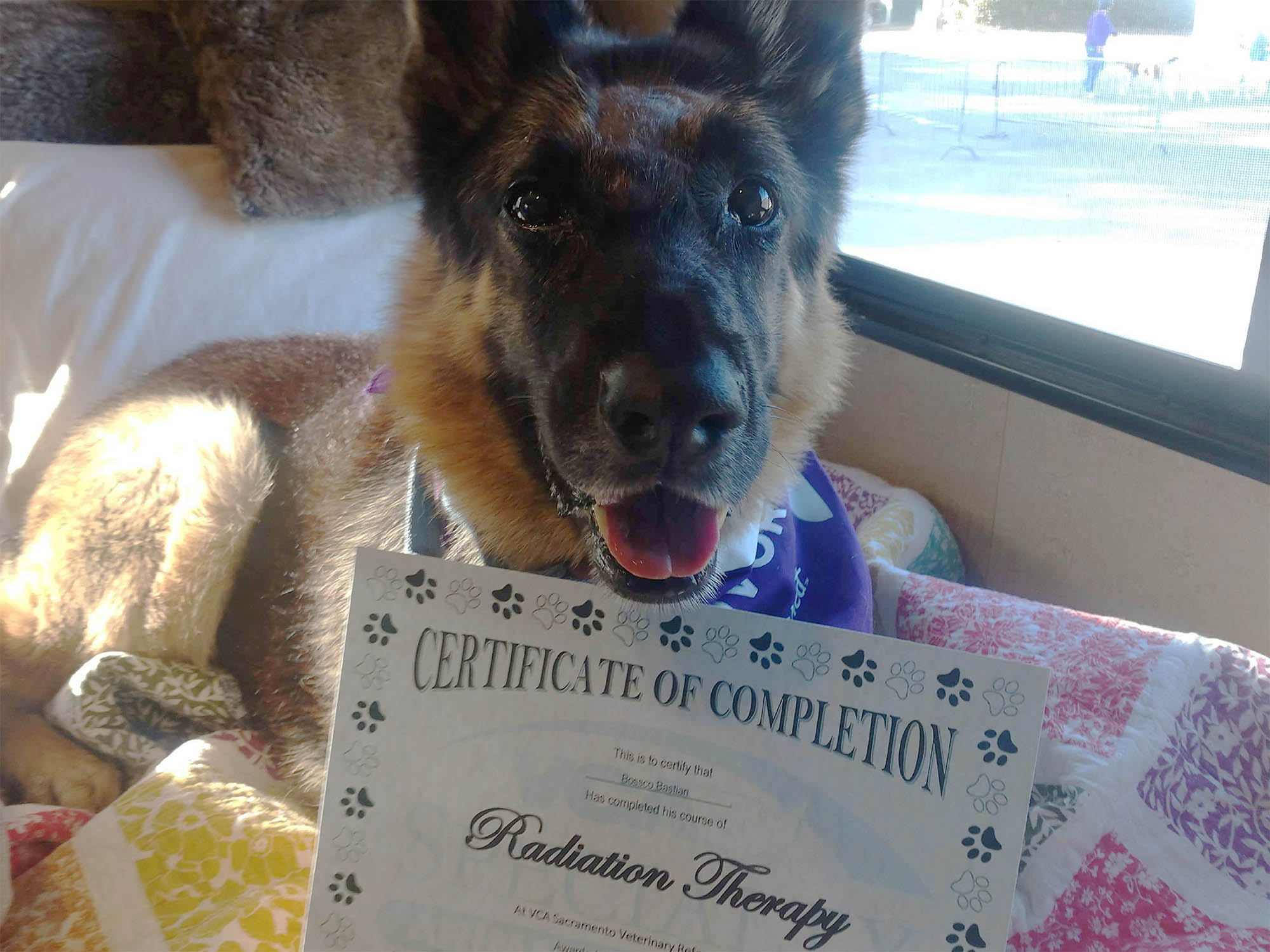As a veterinary specialist in the Zoological Medicine department at VCA South Shore (Weymouth) Animal Hospital, the pets I see are not your typical cats and dogs. Most of my patients are reptiles, birds and small mammals, though every once in a while somebody will bring in a scorpion or tarantula. That can get really exciting! One time, I performed emergency surgery on a scorpion that had torn off part of its claw. To keep its tail safely out of the way, my surgical technician held it with long tongs. Needless to say, she was ready to warn me the moment that tail moved at all!
During my days in practice, I also see nonvenomous snakes. However, even I get surprised when I see a Burmese python as big as Apollo! Twenty years or so ago, these snakes were very popular, and people often got them without learning about them first. As you can imagine, that didn’t go well. These snakes are not for the faint of heart! Many owners didn’t know how big these snakes could get (up to 20 feet long!) or how much they need to eat (sometimes several rabbits a week once fully grown!).
Thankfully, the popularity of big snakes as pets has waned. The few I see are in homes with people who are really good at keeping them and devoted to learning about them.
Snakes seem to get sick (and better) in slow motion
When Apollo came to our hospital, he had signs of respiratory, or breathing, problems. Unfortunately, these are common in big and small snakes. Apollo was congested and wheezing, and there was fluid bubbling from his nose. He’d also lost weight since his last visit.
With respiratory issues like these, I often start snake patients on an antibiotic. If the antibiotic doesn’t improve things, endoscopy may be the next step. During endoscopy, I slide equipment down a snake’s trachea to get samples for testing. These samples help me diagnose the exact problem.

“Best practices for all species are ever-changing. What may have been strongly recommended 15 years ago may be obsolete now.”
Snakes, because they’re cold-blooded animals with slow metabolisms, seem to get sick (and better) in slow motion. This often means that a snake may have been sick for a lot longer than owners realize before they see signs and bring in their pet. Unlike birds and small mammals, snakes can miss a meal or two and be perfectly fine, so ill health can be more difficult to determine. However, as long as we’re not dealing with wounds or other trauma, a snake’s slow-motion health just means that we have a larger window of time to make a diagnosis and determine what to do next.
In Apollo’s case, antibiotic therapy was the first course of action. I also recommended offering a different, larger food source (more rabbits, fewer guinea pigs) to ensure he was getting all of the calories he needed. Since Apollo’s owner also raised some concerns about the snake’s enclosure being too dusty, I suggested switching to a different substrate to cut down on the potential for inhaled irritant.
ZooMed Veterinarians are teachers, too
Almost all of my appointments involve educating pet owners about their unique pet’s special requirements. This often results in the need for changing enclosures, feeding, and other areas of husbandry. This is not because the owners are falling down on the job, but because these animals aren’t domesticated and haven’t been living in our homes for thousands of years like cats and dogs. Exotic-pet owners are like zoo keepers. They create deserts indoors for bearded dragons. They build mini- tropical rainforests for macaws. And it’s always imperfect, because some animals struggle with even the best environments based on the latest research about them.
My job is to diagnose and treat pet illnesses and, even more, to offer owners updated information about their pets. Best practices for all species are ever-changing. What may have been strongly recommended 15 years ago may be obsolete now. During a patient’s visit, I help share what’s state-of-the-art today.
I’m happy to report that Apollo responded well to his antibiotics. And, yes, he’s wide awake and not sedated in the picture (he’s not at all aggressive). And, yes, as you see in the photo, it takes a whole team to maneuver Apollo any time he comes in!
Dr. Stephen Dyer is board certified in avian medicine by the American Board of Veterinary Practitioners. Other than a brief hiatus, he has been a member of the staff at VCA South Shore (Weymouth) Animal Hospital for more than 11 years. Dr. Dyer has expertise in the treatment of all non-traditional pet species—from endoscopy in birds to ultrasound examinations in ferrets—and welcomes consultations with all species of amphibians, reptiles, birds and small mammals. Outside of the hospital, Dr. Dyer enjoys archery, a hobby he picked up during the COVID-19 pandemic. His favorite ice cream is mint chip—it’s the flavor by which he compares all new ice cream places!





